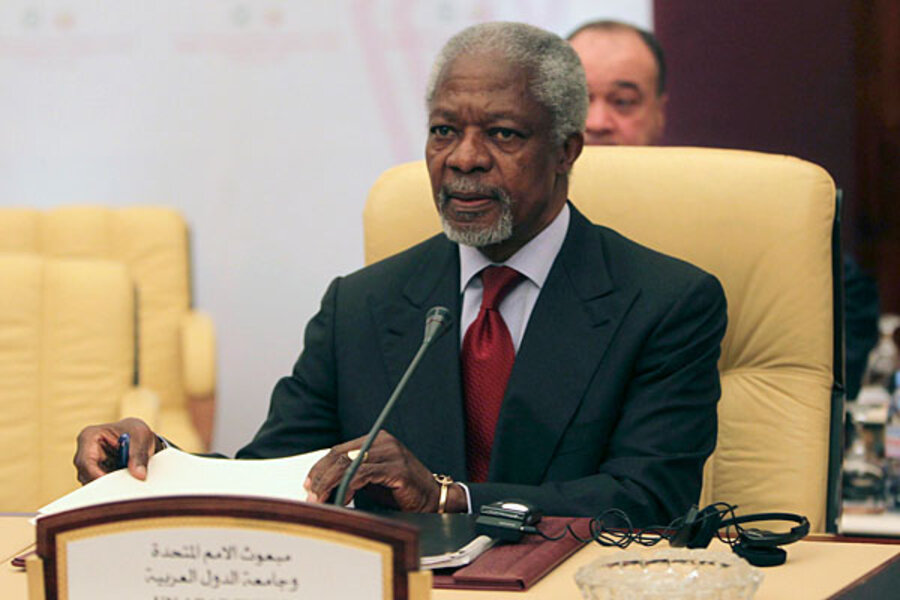As Syria cease-fire falters, Kofi Annan urges faster arrival of UN monitors
Loading...
| Washington
Former United Nations Secretary-General Kofi Annan urged the Security Council to arrange faster deployment of international cease-fire observers to Syria Tuesday, as evidence mounted that Syrian forces are not pulling heavy weaponry out of populated areas as the government agreed.
Evidence also suggests that the government is targeting – even summarily executing – civilians who dare to speak with the few UN monitors already in the country. That has some supporters of the Syrian opposition wondering darkly if more observers will only mean more deaths.
Little if anything occurring in Syria suggests that the cease-fire plan negotiated by Mr. Annan is leading to a decrease in violence, let alone a stabilization that could lead to dialogue and political transition, as also called for in Annan’s six-point plan.
Still, Annan told the Council that a “rapid” deployment of the 300 monitors that the Council authorized last week “might help,” according to diplomats who attended the closed-door session. The monitors are set to reach 30 by the end of the week, according to UN officials. Secretary-General Ban Ki-moon is expected to name a commanding general for the monitors in the coming days, officials said.
Speaking earlier with reporters in Geneva, Annan’s spokesman, Ahmad Fawzi, said the former UN chief would tell the Security Council via video link that “satellite imagery and credible reports” contradict Syrian government claims that it has withdrawn all heavy weaponry from cities and towns.
Diplomats who attended the Council briefing in New York said Annan was particularly alarmed by reports that Syrian forces entered the city of Hama Monday and used automatic weapons to massacre civilians. Such action, if confirmed, could only be considered “reprehensible and unacceptable,” Annan reportedly told Council diplomats. Annan briefed the Council from Sweden.
To underscore the urgency of deploying quickly more of the 300 monitors, Annan also told the Council that the dozen or so observers already in the country have been met with lulls in fighting as they travel around. “When they are there [in an area], the guns are silent,” Mr. Fawzi said. But he added that “when they leave, the shelling starts again.”
More disconcerting still, Annan’s spokesman confirmed reports from opposition supporters that government forces are keeping track of who speaks with the UN observers – and in some cases, as in Hama, returning to deal with them. Civilians who talk to the monitors are later “approached by the Syrian security forces ... or even worse, perhaps killed, and this is totally unacceptable,” Fawzi said.
Events Tuesday suggest that Syria’s rebels are also not holding to the cease-fire agreement. Three officers with the Syrian military were killed in separate attacks around Damascus Tuesday, and a truck bomb exploded in the capital, injuring several people.
But it was action by forces loyal to President Bashar al-Assad that appeared to be taking the highest toll, following the pattern of 13 months of strife in which more than 9,000 Syrians have died.
UN observers returned to Hama Tuesday, where rebels and residents claimed 30 people were killed Monday – a day after residents held a large rally to greet the observers’ first visit to the besieged city. It was the killings in Hama Monday that Annan referred to in his Security Council briefing.
Hama was put on the international map of atrocities in 1982 when the current president’s father, Hafez al-Assad, put down a rebellion in the city with a ruthless onslaught that resulted in 20,000 deaths.





